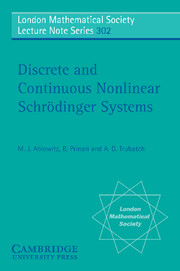1 - Introduction
Published online by Cambridge University Press: 24 October 2009
Summary
Solitons and soliton equations
Ever since the observation of the “great wave of translation” in water waves, by J. Scott Russell in 1834 [146, 147] while he rode on horseback near a narrow canal in Edinburgh, localized (nonoscillatory) solitary waves have been known to researchers studying wave dynamics. Despite Russell's detailed observations, it was many years before mathematicians formulated the relevant equation, now known as the Korteweg—de Vries (KdV) equation that governs those waves (cf. [38, 39, 112]). From the period 1895–1960, the study of water waves was essentially the only application in which solitary waves were found. However, in the 1960s it was discovered that the KdV equation is a relevant model in many other physical contexts, such as plasma physics, internal waves, lattice dynamics, and others. Critically, in their study of the Fermi—Pasta—Ulam lattice equation [75] Zabusky and Kruskal (1965) found that the KdV equation was the governing equation (cf. [189]). Moreover, in a wholly new discovery, Zabusky and Kruskal observed that the solitary waves of KdV are “elastic” in their interaction. That is, the solitary waves pass through one another and subsequently retain their characteristic form and velocity. Zabusky and Kruskal called these elastically interacting solitary waves solitons. The work of Gardner, Green, Kruskal, and Miura [82] showed how direct and inverse scattering techniques could be used to linearize the initial-value problem of KdV.
Information
- Type
- Chapter
- Information
- Publisher: Cambridge University PressPrint publication year: 2003
